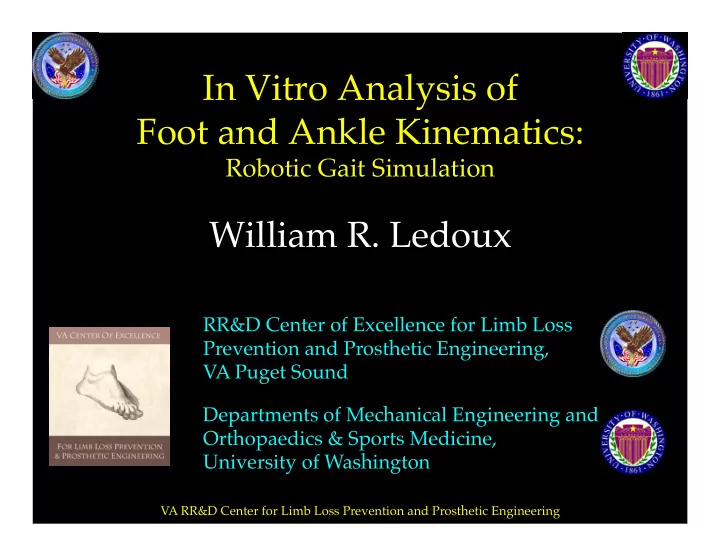

In Vitro Analysis of � Foot and Ankle Kinematics: � Robotic Gait Simulation William R. Ledoux RR&D Center of Excellence for Limb Loss Prevention and Prosthetic Engineering, VA Puget Sound Departments of Mechanical Engineering and Orthopaedics & Sports Medicine, University of Washington VA RR&D Center for Limb Loss Prevention and Prosthetic Engineering
Retro-reflective markers Numerous authors and groups Strengths: dynamic; link foot to rest of the body; capture hindfoot motion Weaknesses: number of markers; rigid body assumption; skin motion artifact VA RR&D Center for Limb Loss Prevention and Prosthetic Engineering
High speed video Not typically published in research studies Strengths: high level of detail Weaknesses: qualitative VA RR&D Center for Limb Loss Prevention and Prosthetic Engineering
X-ray stereophotogrammetry Lundberg A, et al., Foot and Ankle, 9, 1989 Strengths: very accurate and precise; multiple bones Weaknesses: invasive; static; exposure to radiation; cardinal plane motion VA RR&D Center for Limb Loss Prevention and Prosthetic Engineering
Computer Tomography (CT) pes cavus neutrally aligned pes planus Ledoux WR, et al., J Orthop Research, 24, 2006 Strengths: partially weight bearing; multiple bones; foot type Weaknesses: single static position; exposure to radiation; inertial based cs VA RR&D Center for Limb Loss Prevention and Prosthetic Engineering
Magnetic Resonance Imaging (MRI) Fassbind MJ, et al., Journal of Biomechanical Engineering, 133, 2011 Siegler S, et al., Journal of Biomechanics, 38, 2005 Strengths: multiple scanning positions; multiple bones; no radiation Weaknesses: not dynamic; time consuming data collection VA RR&D Center for Limb Loss Prevention and Prosthetic Engineering
Bone pins Arndt A, et al., Journal of Biomechanics, 40, 2007 Strengths: dynamic; multiple bones; gold standard Weaknesses: invasive; not be used in routine clinical care VA RR&D Center for Limb Loss Prevention and Prosthetic Engineering
Fluoroscopy systems De Clercq D, et al., Journal of Biomechanics, 27, 1994 Strengths: dynamic; multiple bones Weaknesses: single plane; exposure to radiation VA RR&D Center for Limb Loss Prevention and Prosthetic Engineering
Fluoroscopy systems Yamaguchi S, et al., Foot and Ankle International, 30, 2009 Strengths: dynamic; multiple bones; 3D-2D model registration Weaknesses: slower frequency; hindfoot only; exposure to radiation; 3D-2D VA RR&D Center for Limb Loss Prevention and Prosthetic Engineering
Fluoroscopy systems Li G, et al., Journal of Biomechanics, 41, 2008 Caputo A, et al., American Journal of Sports Medicine, 37, 2009 Strengths: dynamic; multiple bones Weaknesses: portion of stance; no oblique images; exposure to radiation VA RR&D Center for Limb Loss Prevention and Prosthetic Engineering
Summary of existing methods • Skin mounted markers, high speed video, X-ray stereophotogrammetry, CT, MRI, bone pins, fluoroscopy • Rigid body assumptions, skin motion artifact, static only, invasive and/or exposure to radiation, technology not fully developed VA RR&D Center for Limb Loss Prevention and Prosthetic Engineering
Robotic Gait Simulator (RGS) • R2000 parallel robot • Force/pressure plate (C) • Cadaveric foot (D) • Tibia mounting frame (F) • Steel frame (A) • Tendon actuation (G) – 9 brushless DC motors – Series load cells • 3D motion tracking system (H) Basic idea: invert tibial kinematics, force plate relative to foot, keep rotations the same, and adjust translations (plate position) and tendon forces to match GRF VA RR&D Center for Limb Loss Prevention and Prosthetic Engineering
Robotic Gait Simulator (RGS) VA RR&D Center for Limb Loss Prevention and Prosthetic Engineering
RGS v5 2010 fast dynamic cadaveric gait simulation (2.7s) R2000 Kistler force plate tendon actuators Vicon motion analysis fuzzy logic controller v2.0 40 marker kinematic foot model Aubin PM, et al., 2012, IEEE Trans on Robotics, RGS with FLC Whittaker EC, et al., 2011, Gait & Posture, Foot bone kinematics VA RR&D Center for Limb Loss Prevention and Prosthetic Engineering
RGS v5: GRF 3 learning cycles, 5.6% BW RMS tracking error VA RR&D Center for Limb Loss Prevention and Prosthetic Engineering
RGS v5: Tendon forces RMS tracking error for extrinsic tendons ranged from 2.6N for FDL to 5.6N for TP mean value of 3.9N across all 18 final trials TA and Achilles were adjusted by controller VA RR&D Center for Limb Loss Prevention and Prosthetic Engineering
RGS v5: Ten-segment model Anatomical coordinate systems constructed using two methods: Arbitrary cluster o Direct placement on placement with bony landmarks digitized bony o (6 bones): landmarks tibia/fibula (4 bones): o calcaneus talus o first metatarsal navicular o third metatarsal cuboid o fifth metatarsal medial cuneiform o proximal phalanx VA RR&D Center for Limb Loss Prevention and Prosthetic Engineering
Ten-segment foot model x z y +Z axis: Lateral for right, Medial for left (sagittal plane) +X axis: Anterior (coronal) +Y axis: Superior (transverse) VA RR&D Center for Limb Loss Prevention and Prosthetic Engineering
Recommend
More recommend